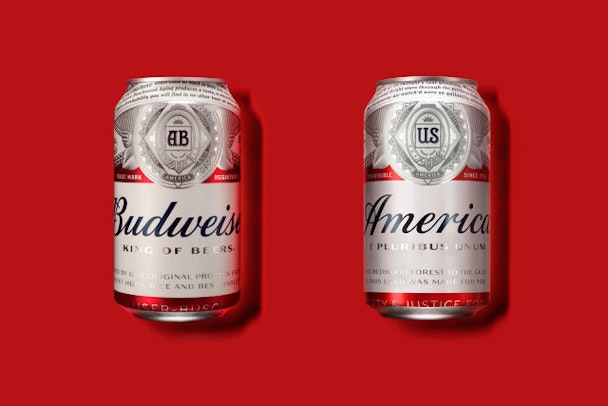Budweiser's 'America': How iconic design allowed for an innovative name change
Budweiser’s temporary rename to ‘America’ is bold and somewhat controversial –everyone seems to have an opinion. But that aside, Budweiser’s move is something more, for those of us who love the art and science of branding. Bud’s 'America' is a manifestation of the power of packaging design and a brilliant reminder of the value of a moniker in marketing.

The current Budweiser can design has been in circulation just since the beginning of this year, when the sideways “bow” design was replaced, a redesign that taps into the rich Budweiser iconography, using design elements that were first used in the 1950s. Through consistent usage and significant media spend, Budweiser has created a design system that today is so recognizable, the marketer has permission to remove its name altogether from its packaging and replace it with a substitute, without fear of misidentification or losing brand equity.
Budweiser is not alone – fellow CPG giants Coke, Pepsi, Snickers and Heinz have all employed a temporary label change in recent years. Coca-Cola’s personalized bottles and cans for the Share a Coke campaign are well known; Snickers last year replaced its name with hunger symptoms on the iconic candy bar packaging; Pepsi stripped its can design down to a single emoji. These brands have in common iconic packaging: design, colors, shapes and logos that even without the name present unquestionably have a specific meaning.
Why has temporary label substitution become a trendy marketing technique?
A name is one of a brand’s most intimate and integral characteristics, a brand asset closely safeguarded by trademarks and rarely (if ever) changed. So why take any liberties with such an important brand element for the sake of a creative campaign?
1. The power of metaphor
By elevating a word or concept to the equivalent of a name, a brand makes a bold statement about what it stands for and should therefore be associated with. A temporary name change gives a brand the freedom to augment or solidify what it means to consumers in a quick and powerful way; it says that the idea is as integral to the spirit of the brand as its name is.
By replacing Budweiser with America on its packaging, Budweiser benefits from all of the associations that the word ‘America’ holds: Budweiser is now even more intimately linked to the ideas of patriotism and freedom. And long after Budweiser loses the America label, the association will remain – the King of Beers is a crisp and refreshing can of pure patriotism. With Share a Coke, Coca-Cola is making a bold assertion– we, as consumers, are so integral to the Coke brand that we can stand in for the name ‘Coke’ itself.
2. The ownership of a concept
If Budweiser is ‘America’, it’s difficult for another beer to make that claim. Snickers alone can cure someone of being dramatic, spacey or cranky. With Share a Coke, Coke is not just a sugary carbonated beverage – it’s Laura, Dan, Sarah. Following the logic, that means that Laura, Dan and Sarah are not Pepsi.
3. Novelty
With the number of communications that inundate consumers today, brands are constantly seeking ways to stand out. When a well-known brand suddenly and temporarily changes the name on its label, not only does it draw the attention of the media, but it also attracts an audience who may not be regular consumers of the brand but are intrigued by the limited nature of the initiative. Much as novelty packaging design or novelty flavors attract new consumers (well evidenced by Lays’ ‘Do Us A Flavor’ campaign), a novelty name change can do the same.
What can other brands learn? When is a name substitution in order?
A temporary name change will only work for brands with instantly recognizable design and packaging; a brand will not benefit from a name change if consumers cannot quickly identify which brand it is.
Secondly, a name substitution is most compelling when the concept is already identified as being important to the brand. After years of US-focused campaigns, it simply would not have made sense for Budweiser to change its label to ‘England’, or even a product trait such as ‘flavorful’, for example. Identifying itself as America follows a succession of increasing commitment to the beer’s association with American patriotism.
Finally, a label substitution should not be taken lightly. It can elevate a concept to the heart of a brand and clarify what consumers should (and determine what consumers do) associate with the company – whether that’s a place, an attitude, an idea or a community. But if done too often, the effect is diluted. If a brand tries to be too many things at different times, it ends up meaning nothing at all. Brands should only make the commitment to a label change – even if it’s temporary – if the substituted concept is so important and beneficial to the brand that it merits a center-stage role.
You can’t be ‘America’ today and something else tomorrow.
Kristen Nozell is a strategist at New York City-based strategy and design firm Red Peak, part of the kyu collective
